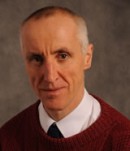|
Plenary
Lecture
Limiting Behaviour of a SIS Epidemic Model with
Environmental Stochasticity

Professor David Greenhalgh
Reader in Mathematics and Statistics
University of Strathclyde
Glasgow
UK
E-mail:
david.greenhalgh@strath.ac.uk
Abstract: In this talk we extend the classical SIS
(susceptible-infected-susceptible) epidemic model from a
deterministic one to a stochastic one and formulate it
as a stochastic differential equation (SDE) for I(t),
the number of infectious individuals at time t. An SIS
model is an epidemic model in which a typical individual
starts off as susceptible, at some stage catches the
disease and after an infectious period becomes
susceptible again. Such models are often used for
sexually transmitted diseases such as gonorrhoea, or
bacterial diseases such as pneumococcus. We survey some
relevant deterministic and stochastic models in the
literature. We then formulate our basic model. The
stochasticity is introduced as a Brownian motion in the
disease transmission coefficient (equivalently in the
contact rate of infected individuals). This models the
effect of random environmental variation. After deriving
the SDE for the spread of the disease we then prove that
this SDE has a unique positive solution.
For the deterministic model classical results show that
there is a unique threshold value R0D, the deterministic
basic reproduction number, such that if R0D is less than
or equal to one then the disease will die out and if R0D
exceeds one then the disease tends to a unique endemic
equilibrium. We show that for the stochastic model there
is a smaller threshold value R0S and provided that a
condition involving the variance of the stochastic noise
is satisfied then the disease will die out almost surely
(a.s.) for R0S<1. We conjecture that in fact the
variance condition is not necessary. If R0S>1 then we
show that the disease will fluctuate about a strictly
positive level a.s. We discuss the connection between
some limiting values of the stochastic threshold R0S and
the deterministic threshold R0D. We then show that if
R0S>1 the SDE SIS model has a unique non-zero stationary
distribution and derive expressions for the mean and
variance of this stationary distribution.
All the theoretical results are illustrated and
confirmed by numerical simulations. We finish by
discussing two real-life examples: first gonorrhoea
amongst homosexuals and second pneumococcus amongst
Scottish children under two years old.
Brief Biography of the Speaker:
David Greenhalgh graduated from Cambridge University,
Cambridge, UK, in 1980 with a First Class Honours degree
in Mathematics. In 1981 he took Part III Mathematics
also at Cambridge University in which he gained a
distinction. He remained at Cambridge for his PhD in
Operational Research which he completed in 1984. His PhD
thesis was entitled ‘Stochastic Models for Control of
Epidemics’.
From Cambridge he moved to the Department of Pure and
Applied Biology at Imperial College, London, UK, where
he was awarded a Medical Research Council (MRC) Research
Training Fellowship to work with Professor R. M.
Anderson FRS, a leading international expert on
epidemiology. He moved to the Department of Mathematics,
Strathclyde University, Glasgow, UK in 1986 as a
Lecturer. Since then he has been promoted to Senior
Lecturer in 1997 and Reader in 2003. He currently holds
the position of Reader in the recently formed Department
of Mathematics and Statistics at Strathclyde University.
Dr. Greenhalgh has research interests in mathematical
biology and epidemiology. He is an international expert
in mathematical epidemiology and has around thirty years
experience in this area. He has collaborated with world
leading researchers in mathematics and epidemiology such
as Professor Klaus Dietz (Germany), Professor Odo
Diekmann (The Netherlands), Professor Istvan Gyori
(Hungary) and Professor Xuerong Mao (Scotland). He has
published around eighty papers in international refereed
journals, seven book articles and over seventy
conference papers. He is on the editorial board of
fourteen international journals, two as Associate
Editor. He has served, and currently still serves, on
the UK Engineering and Physical Sciences (EPSRC)
Mathematics Peer Review College and has served on many
UK MRC Panels. These are two of the most prestigious
grant giving bodies in the UK. He has also been awarded
substantial research funding from a diverse range of
sources. He has supervised seventeen research students,
fifteen at PhD level. He is widely involved in the
organisation of international conferences and has given
over thirty invited talks, including plenary talks, at
international meetings.
|
